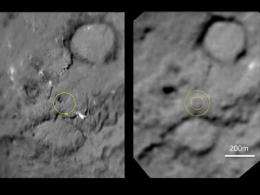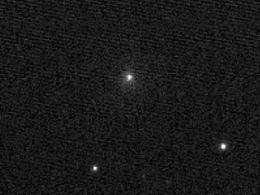Stardust flyby '1,000 percent successful'

In most cases, a Valentine's Day rendezvous that resembles a flight through artillery fire is less than ideal.
But for the hardy Stardust spacecraft, a close encounter with the 88.2-billion-ton (40 trillion kg) comet Tempel 1 on the evening of Feb. 14 was well worth the experience.
"If you ask me, was this mission 100 percent successful in terms of the science? I would have to say -- no," said Joe Veverka, professor of astronomy and principal investigator for NASA's Stardust-NExT mission, at a press conference Feb. 15. "It was 1,000 percent successful."
The mission sent the Stardust spacecraft, which collected dust from the comet Wild 2 in 2004 and dropped it off on Earth in 2006, on a second assignment: this time to Tempel 1 for a new look at the comet that was first visited by the Deep Impact spacecraft in 2005.

Six years ago, Deep Impact sent an 800-pound probe smashing into Tempel 1, giving scientists new information about the comet's structure and composition -- but also creating a plume of ejecta that obscured the resulting crater.
One of the new mission's goals, therefore, was to get a first look at that crater, which could tell researchers more about how the comet formed and evolved. Scientists also hoped to see how the comet's surface changed after an orbit around the sun, and to get a look at terrain that hadn't been seen before.
The flyby met all three objectives, Veverka said. Among the 72 resulting high-resolution images, some show the crater, which is about 150 meters in diameter with a small mound of debris in the center -- material that was sent flying by the impact and fell back to the surface.
Other images show an area that was heavily pitted in 2005, but is smoothed out in the new images, indicating substantial erosion. And images of new territory show a variety of intriguing features, including areas of extensive layering.
"To understand how this comet works, we have to put everything together," Veverka said.
The spacecraft also used two external instruments to detect and analyze the dust surrounding the comet's nucleus. And at just 112 miles (181 km) apart at closest approach, there was a lot of dust to fly through -- not to mention larger particles that battered the spacecraft in fits and starts.
"This is the way comets act," said Don Brownlee, Stardust-NExT co-investigator and astronomy professor at the University of Washington. "They don't just spew off things in a uniform way. They send it out in bursts and puffs ... clods of dirt and ice and rock that come apart. So a good analogy [would be] a B17 in World War II flying through flak."
Overall, it was an exceptional mission, Veverka said, and a thrill to use a spacecraft that had already completed one mission to observe the aftermath of another.
And crucial to the mission were the scientists and engineers around the world who positioned the spacecraft at exactly the right place at the right time, he added. "That was a great achievement," he said. "We are tremendously happy."
Stardust-NExT is managed by JPL, a division of the California Institute of Technology in Pasadena, for the NASA Science Mission Directorate. Lockheed Martin Space Systems built the spacecraft and manages day-to-day mission operations.
Provided by Cornell University





















